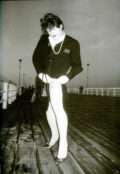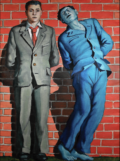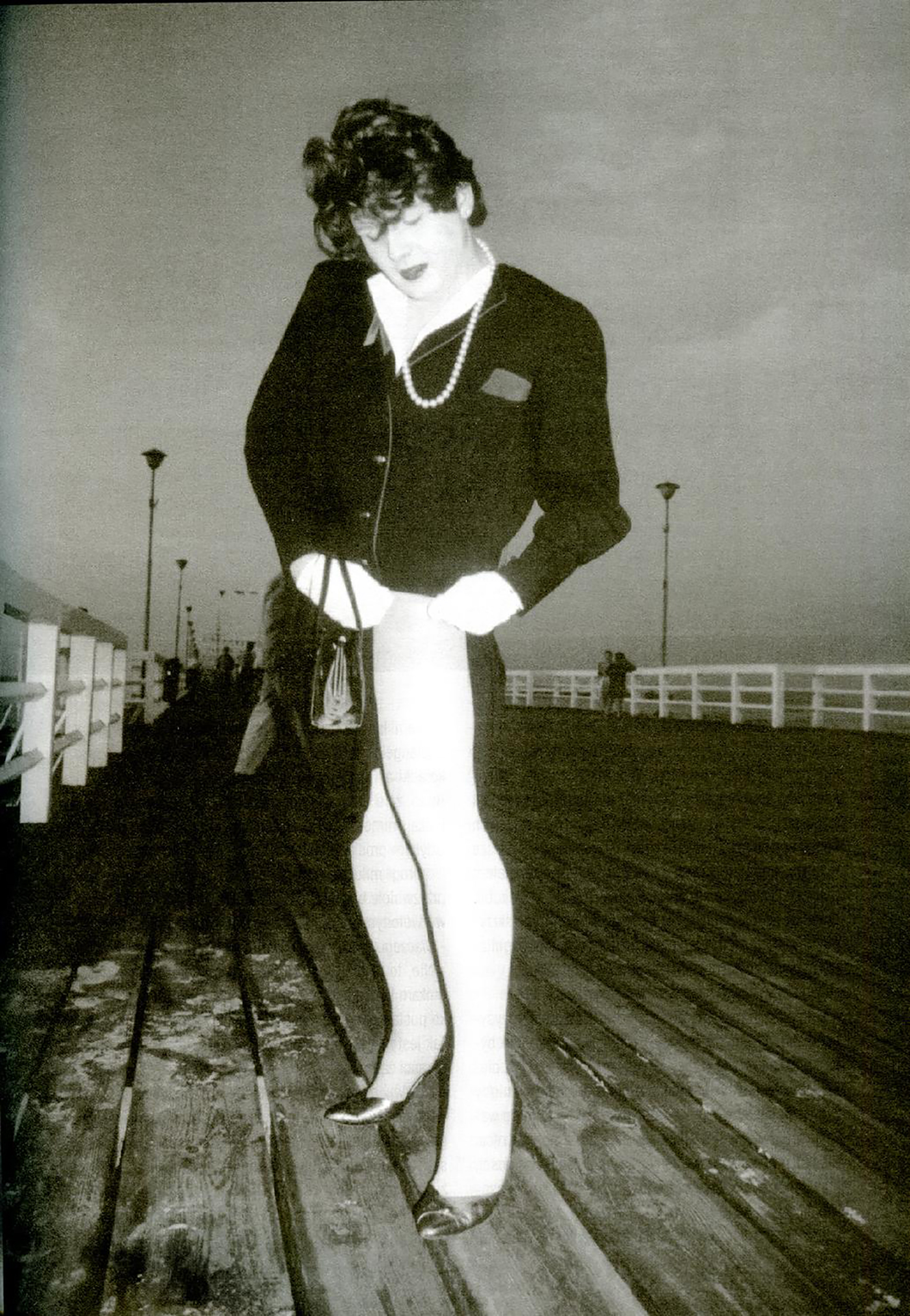
Title
Dispersed Practices: Non-Heteronormative Art in the Filo and Czereja zines Nieheteronormatywna twórczość na łamach zinów „Filo” i „Czereja”
https://www.doi.org/10.48285/8kaemzco3p
http://miejsce.asp.waw.pl/en/rozproszone-praktyki/
Abstract
The article is devoted to two magazines: ”Filo”, published from 1986 to 2001 (as a zine until 1990), and ”Czereja”, published from 1992 to 1998. Although their target readership was different and the magazines resulted from different initiatives, both presented and discussed non-heteronormative art. The goal behind their juxtaposition is to trace the roles and ways of using such artistic practices in both magazines. The approach to analyzing ”Czereja” adopted in the text – against the background of content published in ”Filo”, which participated in the beginnings of the gay movement in Poland – opens up the possibility of determining and highlighting the character and functions that informed the presentation of non-heteronormative art. As opposed to ”Filo”, which developed new modes of representation for the good and in the interests of the community, ”Czereja” adopted a much more contestation-oriented and confrontational character. The key aspects of Filo – particularly in its visual layer – may be discerned in the affirmation of homosexuality as well as opposition to the taboo regarding the male body and its desire. In turn, in ”Czereja”, non-heteronormative artistic practice and the question of queerness were among the areas that made challenging social norms possible. Although these issues were instrumentalized in ”Czereja”, the sheer fact that non-heteronormative content appeared in the field of art and the Academy testifies to the emancipatory character of the zine.
DOI
The variety of zines poses considerable difficulties in formulating a succinct, unambiguous definition of the medium. Plenty of definitions exist,1 and if we were to trace common denominators, the distinctive qualities of zines would certainly comprise material ephemerality, the experimental character of form and content, not-for-profit activity, and presence in alternative circulation (beyond the official, codified publishing market). One of their general characteristics is that they offer space for completely unconstrained expression and for a variety of voices to be heard – those that exist beyond social norms, marginalized, the voices of minorities. The magazines discussed in this article developed such a profile by offering room for non-heteronormative art.
This text looks at two titles: Filo, which was published between 1986 and 2001, and operated as a zine until 1990 (these changes are discussed in detail further in the text), and Czereja, published between 1992 and 1998. Although their target audiences differed and the magazines grew out of different motivations and initiatives, both presented and discussed non-heteronormative art. Non-heteronormativity refers here to the subjectivity of the artists, their identities, as well as the topics of their works. Notably, the discussed artists made use of completely different terminology at the time (such as “gay,” “lesbian,” “homosexuality”), whereas the categories of non-heteronormativity and queer used in this text originate from the modern-day methodological approach.
Filo concentrated on gay communities and formed part of a culture – sprouting in different centers and places – that can be defined today as queer. Its mission embraced delivering cultural news, and announcing events and publications that at least to some extent addressed issues concerning homosexuals. Filo also initially intended to discuss important social topics. Furthermore, the magazine went all the way from an informal zine in the 1980s to a magazine distributed commercially in shops in the 1990s. The art-zine Czereja, released at the studio of Grzegorz Kowalski at the Academy of Fine arts in Warsaw,2 published statements by students (but not only) and was addressed mainly to the student milieu. The history of the two magazines intersected in the 1990s, although they functioned in two different realms and never collaborated with one another. What matters to me, however, is that both titles participated in the shaping of queer culture. Czereja may be recognized as an artistic phenomenon whose interpretation can incorporate the notion of queer in a way that is authentic and not imposed: it addressed the topics of non-heteronormativity in a straightforward manner. The objective behind the juxtaposition of the two titles in this text is to trace the role and ways of using non-heteronormative artistic practices in both magazines. My approach to the analysis of Czereja in comparison to the contents of Filo (which participated in the early days of the gay movement in Poland) also allows me to determine and distinguish in a better way the character and functions that informed the presentation of non-heteronormative creative practices. The first part of this article briefly outlines the origins and general history of Filo and Czereja; the second part reviews non-heteronormative art published in both zines in order to pose a question about its function in social circles and art. The answer offers the possibility of reconstructing a certain fragment of history and, in the concluding section, indicating important aspects for understanding today’s culture.
It is noteworthy that the topic of gay zines has already been addressed in such significant publications as Normy widzialności. Tożsamość w czasach transformacji [Norms of Visibility: Identity in Times of Transition] by Magda Szcześniak,3 Transnational Homosexuals in Communist Poland by Łukasz Szulc,4 and studies devoted to the beginnings of the gay movement in the Polish People’s Republic by Agata Fiedotow, among other titles.5 Furthermore, studies of key importance in the context of artistic practices have been conducted in the field of gay and lesbian studies by Paweł Leszkowicz,6 whose reflections draw from queer methodologies to point at potential alternative visions of Polish art.7 Another important publication is Karol Sienkiewicz’s popularizing book devoted to the Polish art of the 1980s and 1990s, including the milieu of Grzegorz Kowalski’s studio (known as “Kowalnia”) and Czereja.8 The Queer Archives Institute project, developed in recent years by Karol Radziszewski, is also of considerable importance.
Filo: origins, history, transformations
Filo was a project by Ryszard Kisiel, initiated in 1986 and joined later by a broader circle of editors. In 1988, Kisiel ceded his position to Remigiusz Placyd, who was replaced as editor-in-chief in 1989 by Piotr Płatkiewicz (under the pseudonym Artur Jeffmański). Łukasz Szulc, a researcher of the zine’s early days in the 1980s, concludes that living in Gdańsk allowed Kisiel to establish contact with homosexual sailors, who provided him with gay magazines primarily from Germany, England, and the Netherlands, which inspired him to publish his own periodical9; he also received such magazines by post. Szulc’s interview with Kisiel, among other sources, reveals that the reason that compelled him to set up the zine was the “Operation Hyacinth” (1985–1987)10 of the Security Service (SB). This involved mass interrogations and the compilation of a database of homosexual individuals, which resulted in their files being registered and the so-called “Cards of a Homosexual.” One of the consequences of the oppressive action was the intensification of the atmosphere of conspiracy in gay milieus; it is noteworthy that, instead of a single uniform environment, they rather comprised isolated groups, communities, and cliques. Kisiel explains that those circumstances compelled him to establish a medium for homosexuals that would offer information, and not only publish pornography.11 The “Operation Hyacinth” action was also meant to target the then-nascent organizations that gathered non-heteronormative individuals. Kisiel encouraged – in Filo in 1987, among other occasions12 – the formation of small local groups of non-heteronormative people,13 which in favorable circumstances could lay the foundations for establishing a united, strong, nationwide organization.
Notably, the political situation of the era rendered it impossible for such a magazine to be officially released and accepted for publication by censors. That was why Kisiel found employment as a proofreader at a printing house, and later at a photocopying service, where he could photocopy texts written at home on his typewriter for the first issues of Filo.14 He received paper from readers and former colleagues at the printing house. The print run did not initially exceed 30–50 copies, but reached up to 1,000 copies in later years.15 This number was never officially announced, however, because by virtue of the act concerning the control of publications and performances of July 31, 1981 (abolished in June 1990), “printed matter published as a manuscript in up to 100 copies”16 was exempted from censorship. The publisher quoted that provision in the masthead; moreover, he defined the magazine as a bulletin in the 1980s, because such publications were also excluded from state supervision.17
The informative profile of Filo was initially developed single-handedly by Kisiel, who published lists of books, films, theater spectacles, and exhibitions that featured references to homosexuality and which might potentially interest non-heteronormative individuals. As the years went by, brief listings transformed into more extensive critical reviews penned by various authors.18 The visual layer of the zine also gradually became more elaborate. In comparison with other Polish gay zines of the era,19 Filo published many illustrations, photographs, and artwork reproductions. HIV/AIDS was also a major topic covered in the zine, including information about newly released or available publications and news from the medical field. This question was approached for two reasons – the first bore relation to activism: raising awareness seemed crucial amid an ongoing epidemic; the second was that the topic of HIV/AIDS offered a kind of legal shield: should the zine be challenged by the authorities, its editors could quote activities toward disease prevention.
In the 1990s, the zine entered official commercial distribution as a magazine with a socio-cultural profile. During its initial months, Filo was edited by Jeffmański and published by the Lambda Groups Association – Lambda Group in Gdańsk. Later, in July 1991, the publisher changed to Malpress Press Publishing, founded by Jeffmański due to conflicts that arose with Lambda. The format of the magazine was enlarged, and it was printed in color from 1993. A certain inconsistency can be observed in the subtitles: “Gay Cultural Bulletin,” “Gay and Lesbian Magazine,” “Monthly for those who Love Differently,” “All-Polish Monthly,” “Gay News,” “Gay Magazine,” and “Gay & Les Magazine.” In 1998, Filo changed its title and began to be distributed as Facet, but the numbering of issues continued uninterrupted. It was released until 2001.
Jeffmański became the editor-in-chief during the political transformation period in Poland in 1989–1990, the significance of which was prominently highlighted in Filo. In the editorial note to the October 1990 issue, Jeffmański addressed the transformation of the country’s political and economic realm, observing that: “Strange are these times. Instead of FREE POLITICAL PRISONERS, people now write such slogans on the walls as: SABRINA’S BOOBS, DEPECHE MODE, SRUTUTUTU or PALE IS MY ASS.”20 The editor thus highlighted the redefinition of social interests occurring at the time – from a focus on activities toward liberation from the communist authorities to concentration on the private sphere, or else the public sphere but understood exclusively in terms of popular culture. Jeffmański fused the change in Filo’s structure – the zine’s reorientation toward a commercial magazine – with the social and political regime transformation: “Even FILO ceases to be a secretive samizdat passed from hand to hand. After five years in conspiracy they will display us at a newsagent’s next to POLITYKA, TRYBUNA, PRZYJACIÓŁKA. We feel like a guy who had been sunbathing naked on a regular beach for some years, sweating and hiding so as not to be discovered until one day they told him it was a nudist beach and everything’s OK. He looks around, everyone may indeed be naked, but still it feels kind of dumb…”21
The magazine’s transfer from alternative circulation to mainstream was accompanied, as the above quote shows, by a sense of inadequacy and awkwardness in the new reality. The zine’s editors were somewhat anxious when highlighting that the magazine’s readership would now also comprise readers of the mainstream press. When it operated as a zine in its initial period, Filo was sent to readers in Poland and abroad by post; it therefore reached people who were particularly interested in it – a narrow circle of readers – whereas the change in distribution entailed a direct confrontation with heteronormative society. From a different perspective, the fact that Filo joined the ranks of mainstream magazines can also be seen as a move that offered the possibility of partly reclaiming agency in terms of the manner of representing non-heteronormativity. The editors also observed that the change in status expanded the publishing options, for example by making new printing methods available: “We welcome with pleasure the improved quality of print, but we are sad to reduce the volume (money!). […] We would like to publish more photos, perhaps even add a color poster… We’ll see.”22
Czereja: outline of the zine’s history
The character of Czereja23 also changed during subsequent issues, yet the motivation behind the transformation seems to have been different. The zine was founded by Artur Żmijewski during his studies at the Academy of Fine Arts in Warsaw (1990–1995). He co-edited Czereja with other students from the studio of Grzegorz Kowalski: Monika Zielińska, Monika Dzik, Katarzyna Kozyra, and Anna Niesterowicz, among others – as well as with selected teachers, including Kowalski himself. Żmijewski emphasizes that the objective behind setting up the zine was to spark debate at the Faculty of Sculpture and create a space for reflection on various forms of artistic statement. “One of the goals of this newspaper published until 1996 was also to let others know that a group of artists existed who took interest in social critique and formulated uncompromising statements.”24 Yet, it is noteworthy that this quote concerning social engagement originates from 2008, and may therefore be seen as an element of self-creation. Inspired by the concept of didactic partnership developed by Kowalski, the zine also became a platform on which to engage in polemics – on equal footing and beyond hierarchical relations. Czereja published short descriptions of diploma pieces, excerpts from artists’ texts, interpretations of artworks, as well as essays, poems, interviews, and commentaries on exercises carried out at the Academy’s studios. At the visual level, an important role was also played by Paweł Nowicki’s drawings, which ensured the consistency of the zine in terms of graphic design while also introducing yet another tier of artistic expression.
Czereja had an ephemeral form, and its exact print run – ranging from 50 to 100 copies – proves difficult to determine, as the zine was photocopied multiple times.25 The fifth issue (winter 1995) was published with the support of the Culture Foundation, and the sixth was co-financed by the Pro Helvetia Foundation – both were printed in 500 copies26 using more-advanced technology, and also distributed outside the Academy. Czereja was available for sale – which complicates its status as a zine – but part of the print run was still given away for free.27 Although the magazine was strictly connected to the milieu of Kowalski’s studio and the Faculty of Sculpture, the editors sought to reach artistic circles beyond the Academy. Kowalski played a key role here, by acting as a go-between and distributing Czereja to influential figures in the arts, thus supporting his students.28
An interesting moment in the history of Czereja came with attempts to raise funds to publish it in a more professional form. According to Karol Sienkiewicz, one of the conditions of obtaining funding from the Pro Helvetia Foundation was that part of the sum be invested in improving the graphic design.29 In order to expand the reach of distribution and move from the alternative media circuit to the sphere of magazines with broader readership, it was necessary – significantly – to transform the visual layer and abandon the original design. The layout of content was changed, the font was standardized, and high-quality photographs were published, often filling entire pages or centerfolds. Detailed information was added to the masthead, and contributing photographers were credited. At the same time, the magazine gradually grew in volume – from the six bound A4 sheets of the first issue to almost 70 pages with the sixth issue. As a result of broader distribution, Czereja was mentioned in two socio-cultural quarterlies: Kresy, devoted to literature and art, and Res Publica Nowa, devoted to cultural and social issues.30 Notably, Kresy mentioned Czereja in the “Press Review” section, in an article concerning the category of corporeality in art. The contents of the fifth issue were summarized with a focus on feminist problems, while also referring to Katarzyna Kozyra’s work Pyramid of Animals. Importantly, it was the fifth issue of Czereja that focused on that diploma work: the cover featured a photograph of a fragment of the installation, and an interview with Kozyra conducted by Żmijewski was published31 alongside an excerpt from a critical sketch by Marek Goździewski, a curator at the Centre for Contemporary Art Ujazdowski Castle in Warsaw.32 The inclusion of the interview – during a stormy, nationwide debate about Pyramid of Animals – can be seen as the seizing of an opportunity to propagate the magazine and to smuggle to a broader circulation other texts published in Czereja (and their authors).33 The magazine’s makeover at the formal level required by the sponsor temporarily introduced Czereja to the professional press circuit. In turn, its ever more powerful position in the intellectual milieu, symbolized by the mentions in two high-profile periodicals, contributed to its readership expanding. This did not last for long, however – the magazine ceased to be published after the sixth issue.
Art in Filo
Filo34 initially offered a rather subjective selection of discussed exhibitions, cultural events, and art projects. Ryszard Kisiel wrote about events he participated in or those covered in international gay magazines. He therefore controlled the flow and selection of information. Articles and brief notes concerning international practices, especially those unrepresented in Poland, were published next to information about local exhibitions and artists, often with a lowly position in the art world. In the second issue (1986), Kisiel reviewed an exhibition of “erotic jewelry” at the BWA in Wałbrzych, which was later shown at the BWA in Zielona Góra and at the P.P. Sztuka Polska exhibition salons in Warsaw.35 This was probably the show titled Her and Him [Ona i on] or Eroticism in Jewelry – Her and Him [Erotyzm w biżuterii – Ona i on], which premiered at the BWA in Legnica. Further in his text, Kisiel also mentioned the silver jewelry exhibition White and Black [Białe i czarne] in Legnica. He commented on the works shown in Wałbrzych as follows: […] male sex organs / but not only / made of silver and amber – ideas, ideas!!!”36 And although the exhibition obviously drew on the binary division between the sexes, ignoring non-heteronormativity, the editor of Filo managed to extract from it – however laconically – some content of interest to his readers. By highlighting male genitalia and referring to them in the context of a gay magazine, he achieved a reconfiguration by going beyond the normative “her and him” combination. That approach was essentially tactical, as it involved using a given structure and modifying it in order to make it respond to the principles and interests of the one using it.37
The same issue featured Kisiel’s information about the exhibition planned at the BWA in Legnica by Paweł Jach, an artist affiliated with the BWA in Wałbrzych, whose work was dominated by “male nudes in a realist style.”38 The mentions of both exhibitions clearly highlighted the category of male corporeality, which was – importantly – approached in an affirmative manner. The notes were accompanied by two images that revealed a fascination with the male body and an expression of homoerotic desire. The first, signed with the pseudonym Heinrich Tapitz (who was in fact Kisiel’s partner), portrayed a lying male nude (fig. 1). The second was a copy of a piece by Aubrey Beardsley (fig. 2) originating from Ewa Kuryluk’s book Salome albo o rozkoszy [Salome, or about Ecstasy], published in 1987, which Kisiel had mentioned in the fourth issue of Filo in 1987. It depicted a scene from Lysistrata by Aristophanes, a comedy in which women deny men sex in order to bring the Peloponnesian War to an end. In Filo, the image was deprived of its context and reduced to a mere representation of oversized male genitals. Paweł Leszkowicz connects this outburst of erotic expression in the 1980s with a return to what had been repressed in Poland under communism, where the nude male body was considered taboo. According to Leszkowicz, that would explain the presence of such grotesque and often deformed images.39 A similar explosion of sexual energy can be seen in an interview conducted in 1990 (after the collapse of communism) with the German illustrator Ralf König, some of whose comic books address homosexual themes (fig. 3).40 This conversation is striking for its chaotic, almost oneiric character, overwhelming the reader with the multiplicity of covered topics. It also makes direct and unconstrained reference to the artist’s own sexuality, including his first sexual contacts and coming out. Furthermore, the language of the interview is hyperbolic. Magda Szcześniak analyzes this manner of making statements, which stirs controversy not only in normative society but also in some gay circles, by setting it against the background of the normalizing language of the political and economic transformation.41 Following this perspective, the interview may be considered on the one hand as a conversation that functions beyond the logic of transformation, and on the other hand – in the context of non-heteronormative identity – as part of a project that is emancipatory rather than assimilatory.
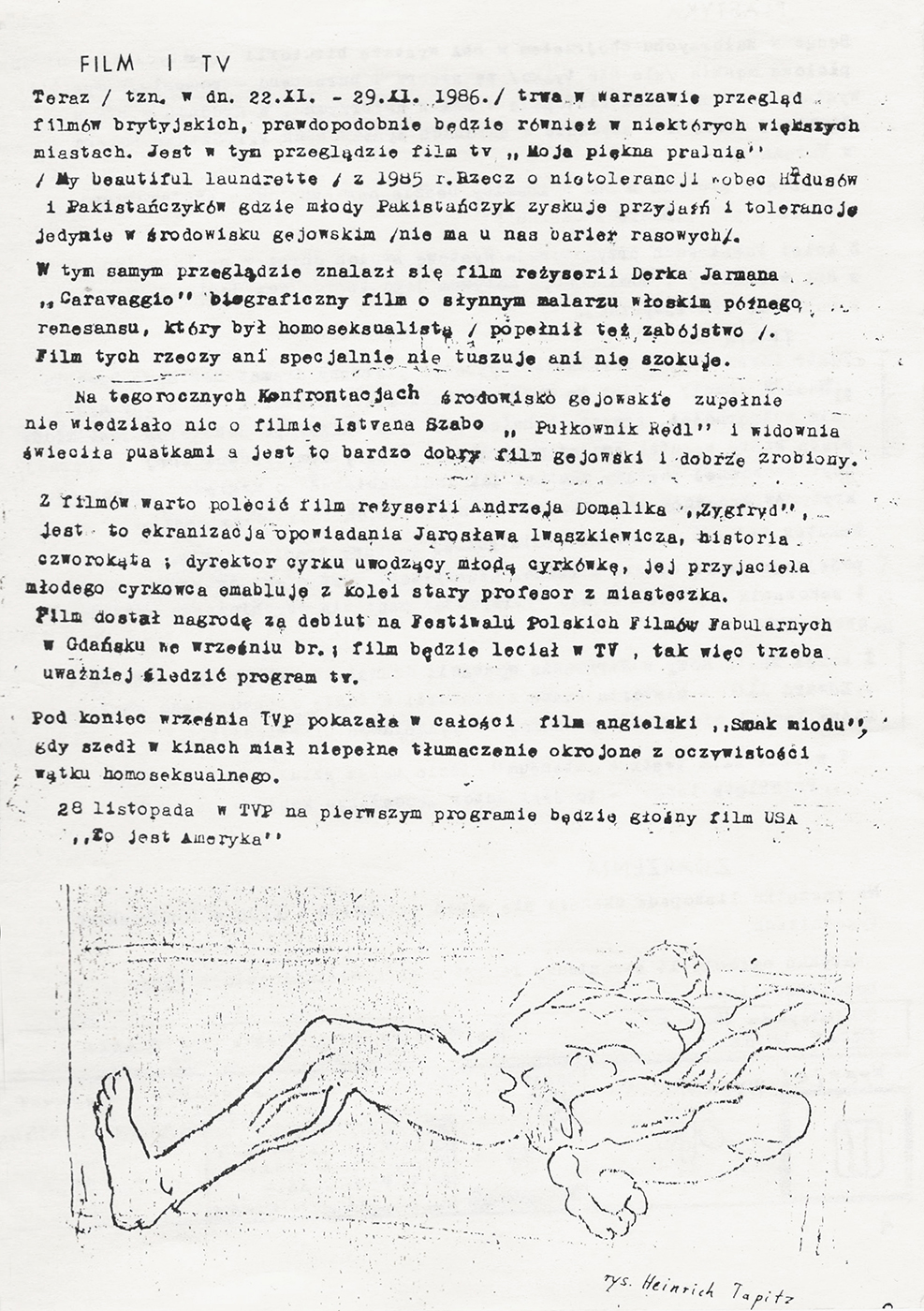
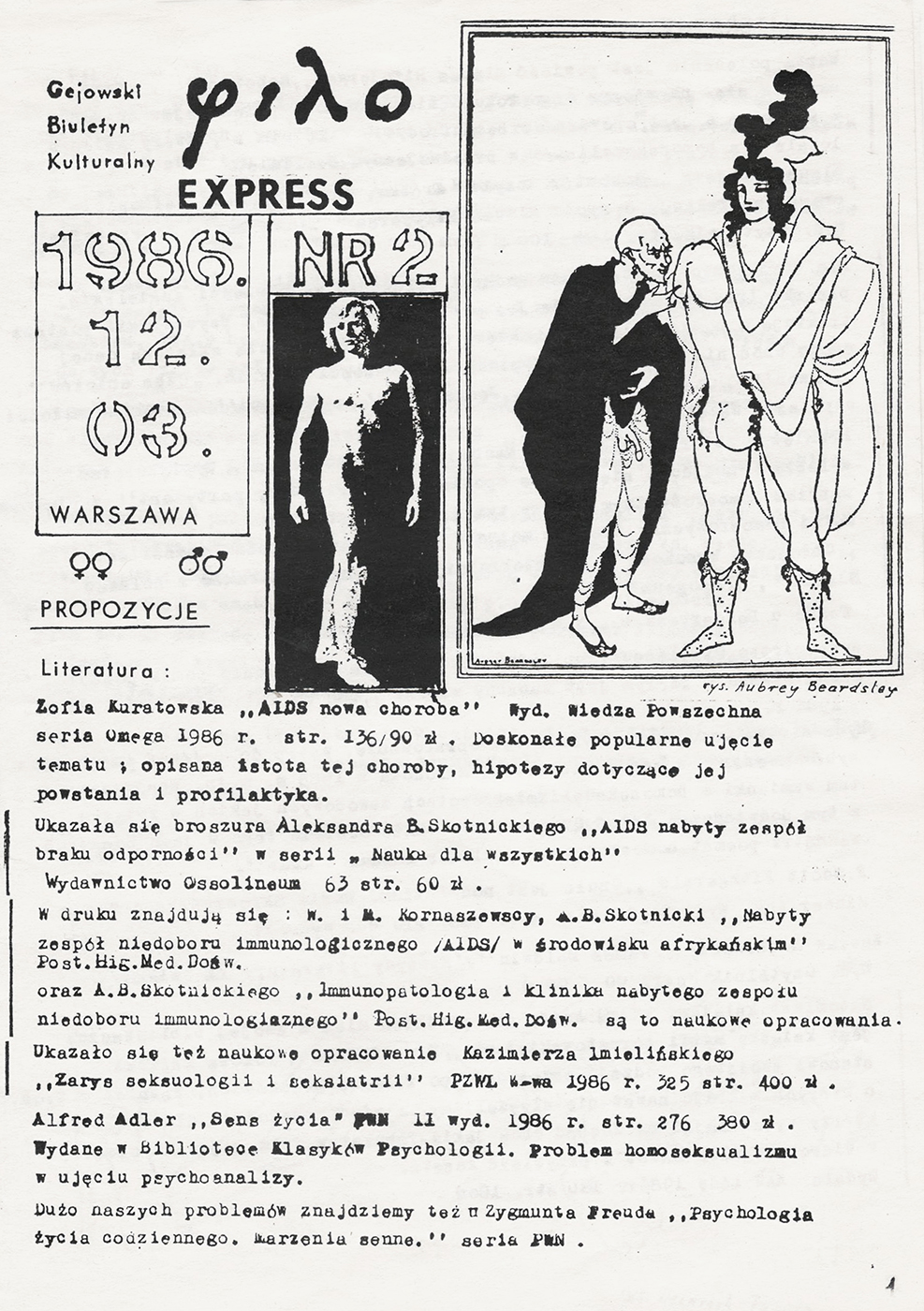
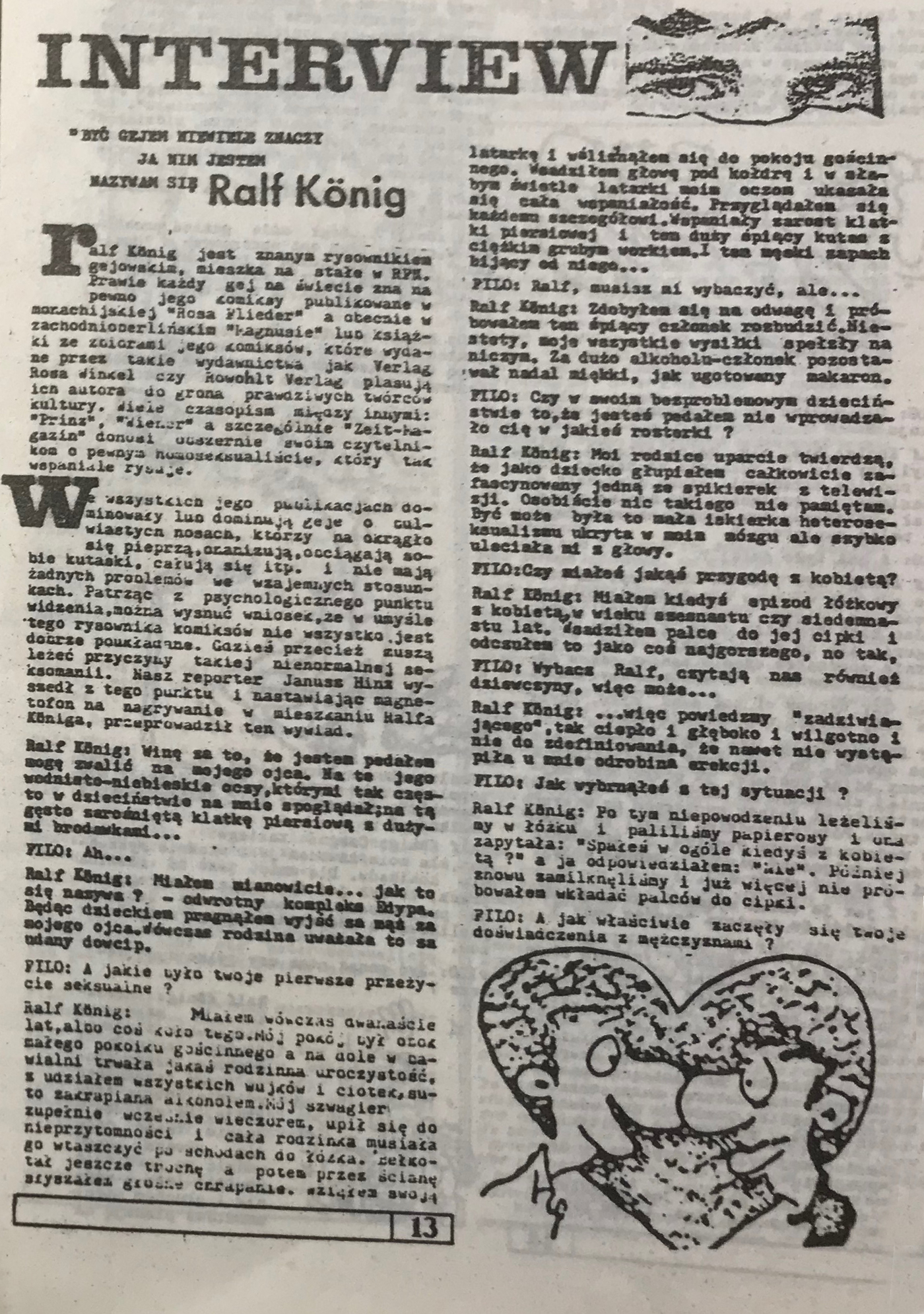
A similar tone characterizes a text devoted to the work of Tom of Finland.42 His drawings were reproduced in a number of issues of Filo – before the zine transformed into a socio-cultural magazine – in the “Gallery” section (figs. 4–6), created specifically for that purpose. The publication of this series was inspired by the release of the retrospective album Tom of Finland 1946–1988. As the authors of one of Filo’s articles devoted to the artist explain, the considerable cost of the publication and its availability (limited mainly to the United States) effectively made it impossible for the Polish reader to explore, and it was therefore decided to present these otherwise unavailable materials in the zine.43 Delivering information reprinted from other magazines or studies, and reproducing artworks difficult to access in Poland, were also tactical activities.

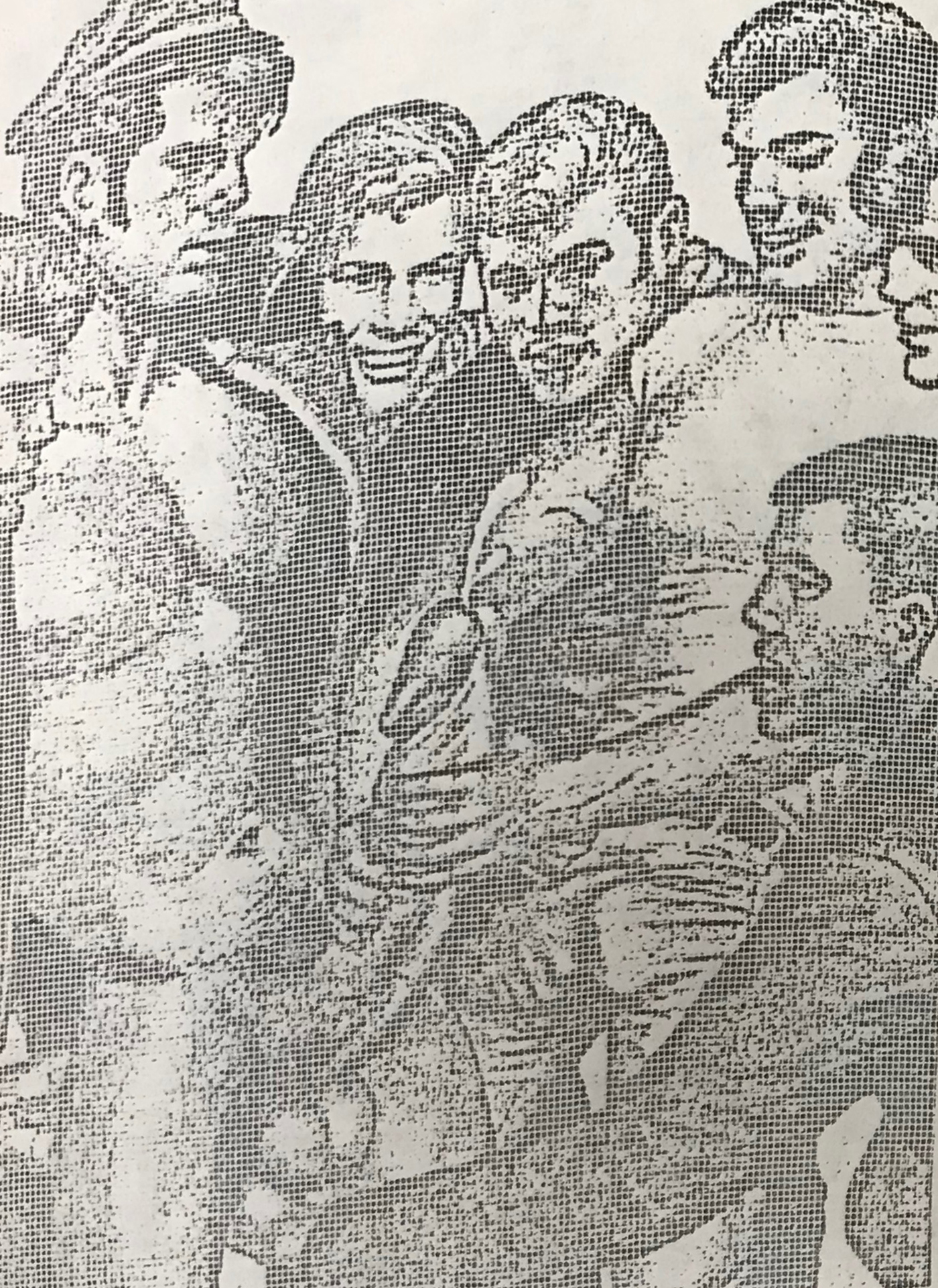
The zine highlighted the influence of Tom of Finland’s work on gay culture, underlining the strong gay-macho model that the artist created. Yet, the connections of that convention of representation and imagery with such categories as domination and authority were disavowed. The focus was on the community and brotherhood aspect of Tom of Finland’s works, and the fact that they propagated an approach based on “friendly equality” and “homoerotic friendship.”44 At the same time, emphasis was placed on the duality of the world pictured in the illustrations: they offered the possibility of identification with the depicted situations, but they were also utopian – “The sites of action: parks, gas stations, bars, are like solitary islands that serve not only emotional-visual joy, but are also a paradise discovered ever anew – again and again, at every moment – untainted by AIDS and the ruthless passage of time that makes us grow older.”45 Notably, at the time of the epidemic, the presented images ignored the problems of infection, illness, transience, and old age, developing a vision that was as affirmative as it was false. Against the backdrop of the HIV/AIDS epidemic, such images, focused on the muscled body and the promotion of physical strength, invited the criticism of the American activist organization Queer Nation. Nevertheless, the idealization present in Tom of Finland’s works, which disregarded negative elements and weakness while exaggerating pleasure, muscularity, power, and sexuality, seems important in the context of building positive models for men with a homosexual identity and introducing such models to Poland. Perhaps the publication of Tom of Finland’s drawings in Filo was an attempt to do away with the hegemonic discourses that blocked and limited the perception of oneself – a non-heteronormative subject – as a separate individual whose rights were unequal to those who conformed to the heterosexual norm. Of particular interest are the reproductions of two of the artist’s works published in the 1990 issue next to Sławomir Starosta’s article “Ruch homoseksualny w Polsce. Dlaczego? Dla kogo? W jaki sposób?” [The Homosexual Movement in Poland. Why? For Whom? How?],46 in which the author shared his views on the movement’s political objectives, proposing assimilatory and normalizing activities,47 completely at odds with Tom of Finland. That juxtaposition may be explained by Filo’s lack of a clearly defined program – the zine’s content resulted from negotiation and attempts to confront the plethora of co-existing discourses that emerged in Poland during the 1990s.48
Those negotiations became apparent with the zine’s entry into mainstream publishing circulation. In subsequent years, Filo presented the works of renowned and established artists from different eras, such as Michelangelo (fig. 7), Andy Warhol, and Robert Mapplethorpe. Although the question of non-heteronormativity retained key importance in those articles, and corporeality was still affirmed, the sphere of sexuality was no longer approached hyperbolically. The language also changed, becoming almost devoid of vulgarisms, neologisms, grotesque alterations, and the straightforwardness that had characterized earlier issues. Yet, whereas the linguistic layer somewhat softened and thus adjusted to the norms of the mainstream media, reflecting acceptable social norms, the visual layer continued to feature male nudes, as had been the case in the earlier period. It can be assumed that the difference between the levels of language and visuality resulted from Filo’s profile as an erotic magazine focused heavily on depictions of nudity. It seems that such imagery was a predictable and expected part of such periodicals. The change in terms of language might have been caused by the sense of the magazine’s considerably extended reach, due to which its readers became increasingly anonymous to the editors. Distribution by post had a much more personal dimension to it and allowed for a certain freedom, as it essentially implied consent given by particular readers to the presence of specific kinds of content. Yet, importantly, throughout the magazine’s entire history, even after it attained mainstream circulation, the affirmation of non-heteronormativity, especially with regard to homosexual men, continued to maintain a prominent presence.
Non-normativity in Czereja
At the visual level, Czereja explored the borders of what was socially acceptable – and challenged them. It provided a space of revolt against the aesthetic order that prevailed at the Academy, offering room for transgressive imagery and subversive writing. Unlike Filo, which developed new modes of presentation for the good (and in the interests) of a certain community – albeit without formulating an overarching program – Czereja was much more confrontational and controversial. This can be clearly seen, for example, in Paweł Nowicki’s drawings in the early issues. These were mostly contour drawings that often portrayed imaginary, unreal figures, and sometimes fragments of bodies merged with various objects, or their cross-sections, as if derived from an anatomical atlas. Such imagery would be hard to come across in the mainstream press. The images in Czereja manifested a completely different aesthetic, often experimenting with it, lending prominence to marginalized motifs. Non-heteronormativity was not addressed directly in the published images; however, their hybrid and volatile form, which blurred the boundaries between female and male genitals, and their grotesque character, which stirred repulsion and disgust, maintained a significant connection with what was socially unacceptable and undesired, thus challenging heteronormativity. Notably, Czereja was co-created by a circle of artists who did not need to rely on pre-existing images – as was often the case with Filo – but who could create them. At the same time, questions of sexual identity did not hold a dominant position in Czereja, as opposed to Filo, where they were the central topic, albeit explored at the social level. The first four issues of Czereja, published at the editor’s own expense, mainly concerned the functioning of the Academy and the work produced in Grzegorz Kowalski’s studio, the pursued didactic curriculum, and the artistic practice of the studio’s students. The target readership of these early issues was also significantly narrower and limited to academic circles. Change was ushered in only by the availability of external funding, a different mode of distribution, and the abovementioned debate and controversies around Katarzyna Kozyra’s diploma piece. Czereja was not the only example of such content offered in publications of the time from the field of art – in this respect we could also mention Magazyn Sztuki, published by Ryszard Ziarkiewicz from 1993; the Transgresje [Transgressions] series, edited by Maria Janion, which had been published since the 1980s; and Tomasz Kitliński’s feminist-gay zine Rewia Kontrsztuki, present in unofficial circulation between 1991 and 1993, which combined “literary, artistic, and sexual revolt.”49 However, as for Czereja, it seems essential to recognize such hitherto unanalyzed threads present in the magazine.
As emphasized by Sienkiewicz, the materials that provided the basis for the editors to work on the fifth issue of Czereja in 1995 had been brought by Katarzyna Kozyra from the United States. We can therefore assume that the artist inspired the general outline of this issue.50 Furthermore, I believe that in the context of Czereja and the young artists who created the zine, it was particularly important to determine a certain vision of reality, to draw up an artistic manifesto, to form a common front – the final two issues stood a chance of reaching a greater number of readers owing to the larger print run and broader distribution. The fifth issue contained reprints from the publication Angry Women,51 carried back by Kozyra. Those were two interviews conducted by Andrea Juno, with Annie Sprinkle52 and with Diamanda Galás.53 Sprinkle (fig. 8), a sex worker, actress, porn producer, editor of erotic magazines, artist, sexologist, educator, and lesbian, cited many biographical threads in the conversation, explaining the beginnings of her fascination with sexuality and the reasons behind her need to demystify corporeality. She also returned to the early days of her artistic work and her collaboration with the performer Linda Montano, who influenced her first projects, for example by inspiring her to record the verbal abuse Sprinkle received while providing sexual services and turn it into an artwork. It seems that the mechanism of the social exclusion and repression of sexuality was one of the reasons why Sprinkle placed such emphasis on the pursuit of pleasure, observing the social primacy of martyrdom over hedonism, as well as widespread negative views on the avoidance of suffering and an approach to life based on the desire for sensual pleasure. Her orientation toward sexual satisfaction and fulfilment demystified in a certain way the social perception of sexuality.
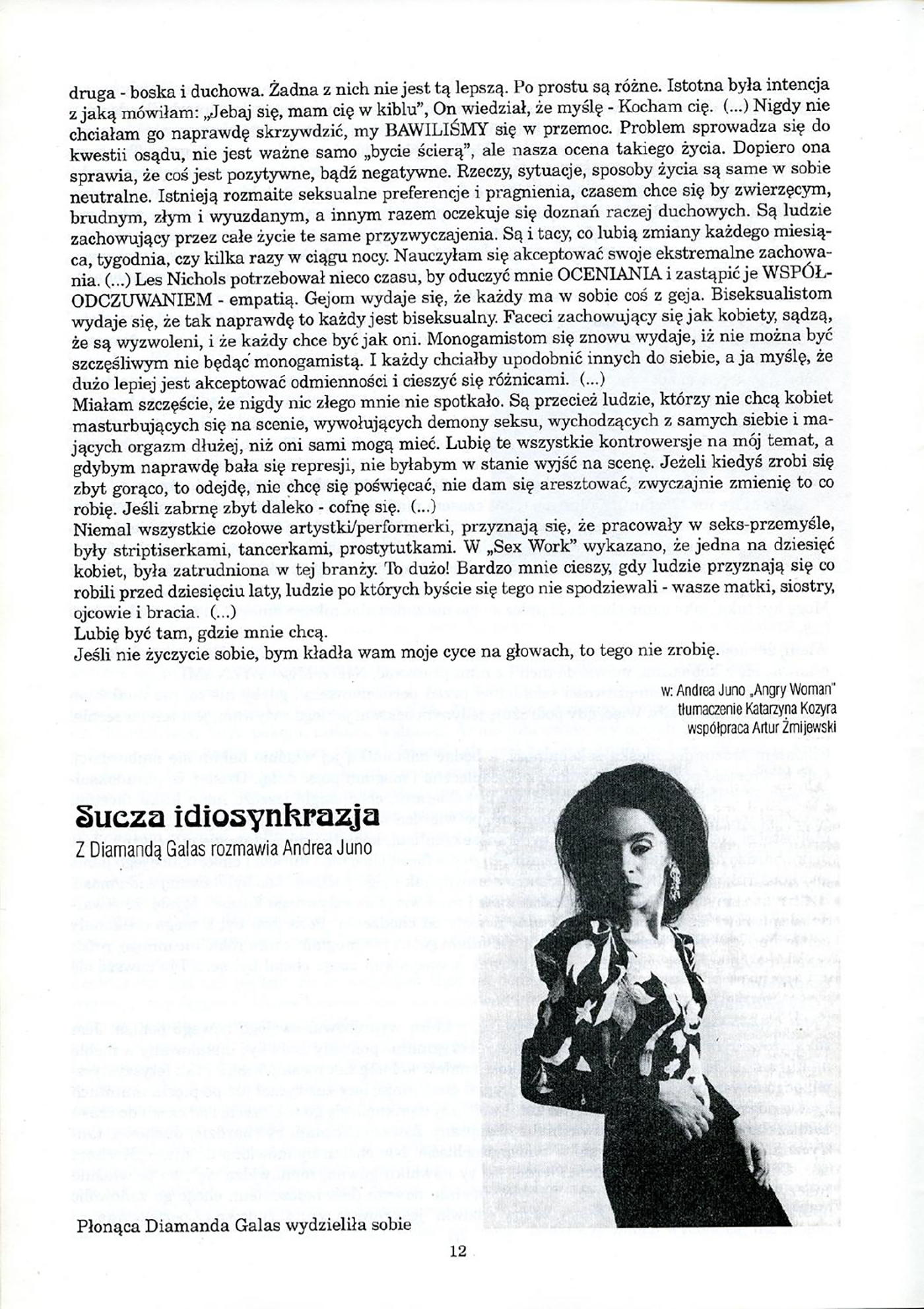
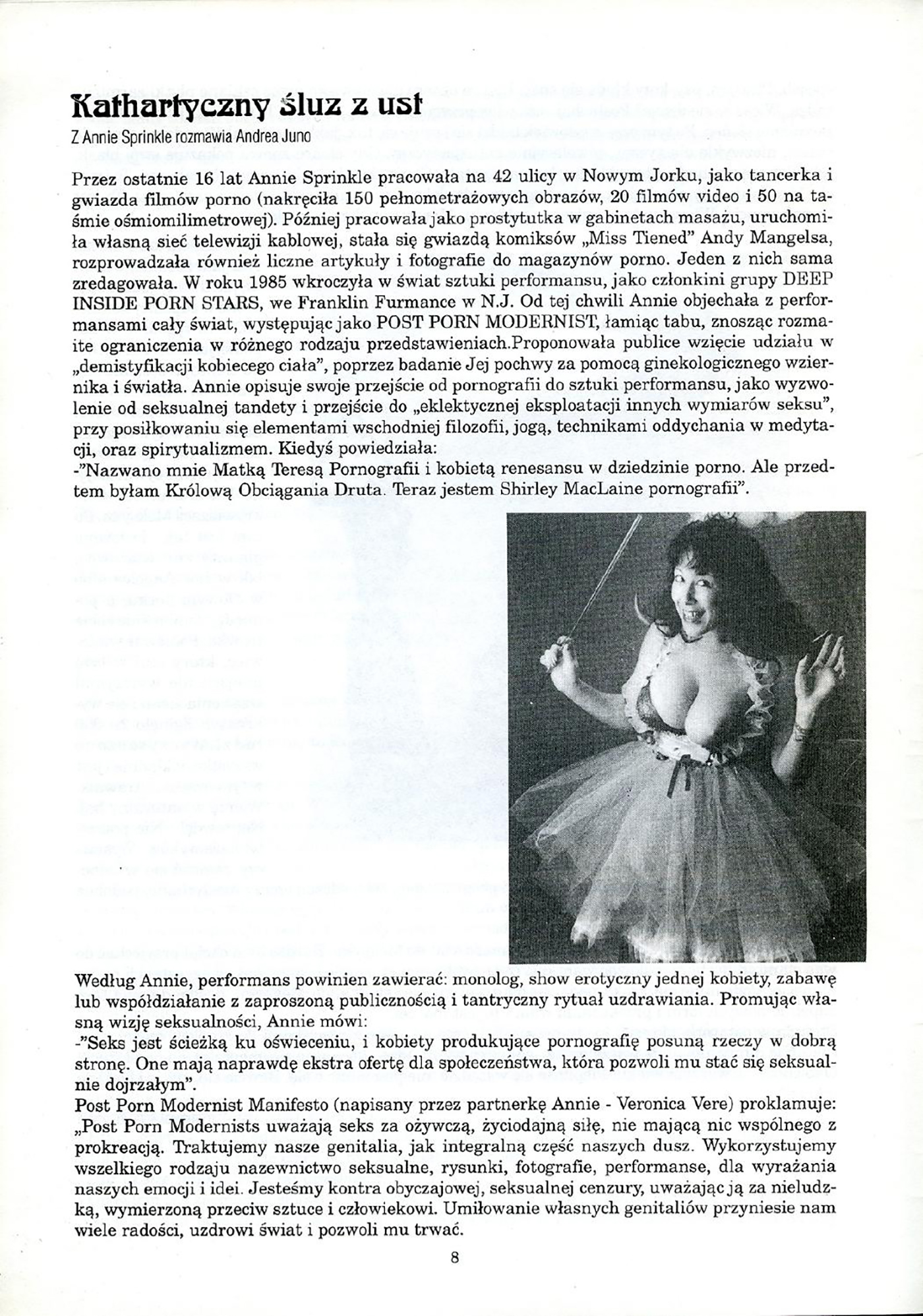
Published next to the conversation with Sprinkle was an interview with Diamanda Galás (fig. 9), a performer, composer, and vocalist. Her statements manifested a completely different character. Notably, Galás concentrated primarily on the problems of mental illness, HIV/AIDS, mourning, despair, and injustice. In the interview, she described her voice as a political tool, comparing it with the voices of witches and shamans – who combined the traits of women and men. Significantly, by moving away from the binary division between the sexes, Galás also challenged the model of patriarchal society. Her story was interspersed with references to sadomasochism; she also revisited her experience as a sex worker, a profession she assumed in order to gain power and exploit men financially. She advocated expressions of outrage instead of sorrow or resignation, particularly in the context of HIV/AIDS. Anger was extremely important for her. In the interview, Galás also raised the question of political correctness. She shunned it as something related to a certain kind of submission, which she had no intention of accepting.
The sixth issue of Czereja, which was also published with external financial support, was initially devised54 as a catalog for the exhibition Me and AIDS [Ja i AIDS],55 yet the idea was abandoned. Interestingly, the issue contains the interview titled “Homoartist” [Homoartysta], conducted by Kozyra and Żmijewski with Andrzej Karaś, a student at the Faculty of Sculpture (fig. 10).56 The conversation revolved around his diploma piece, defended at the studio of Professor Stanisław Słonina. Karaś created an installation which comprised a cast of a human body stood on a glass plinth – an aquarium filled with water – set among roses. A frame covered with sheets was built above the figure, and the holes in the fabric allowed access to the interior, but only partly, by “peeping in.” For Karaś, the diploma piece became a form of public coming out, but this aspect was ignored by the professor during the diploma exam. What prevailed were considerations about workshop skills, anatomy, the proper rendition of proportion, and the accuracy of the depicted posture.57 As Karaś admitted, staying in the closet made him feel like a second-class citizen. Yet, the diploma piece did not mean the social acceptance of “showing that being a faggot is OK.” The artist underlined: “I was trying to talk to my professor about the homosexual context of my sculpture. I showed him drawings, I tried to explain… in vain.” And further: “I wanted him to understand me and not to be against my work. But he did not understand anything. He even said that what I’d made was a decoration.” What seems key, however, are the statements of those debating during the exam: “In your diploma piece you’ve used a cast of your body. You’re fascinated with it…” and “you’ve built an altar for yourself.” Such comments situate Karaś’s activity in the context of narcissistic behavior, focusing on the artist’s delight in his own body and thus activating a certain cliché – a mental scheme imposed by heteronormativity – according to which gay people are overly concerned with self-image.
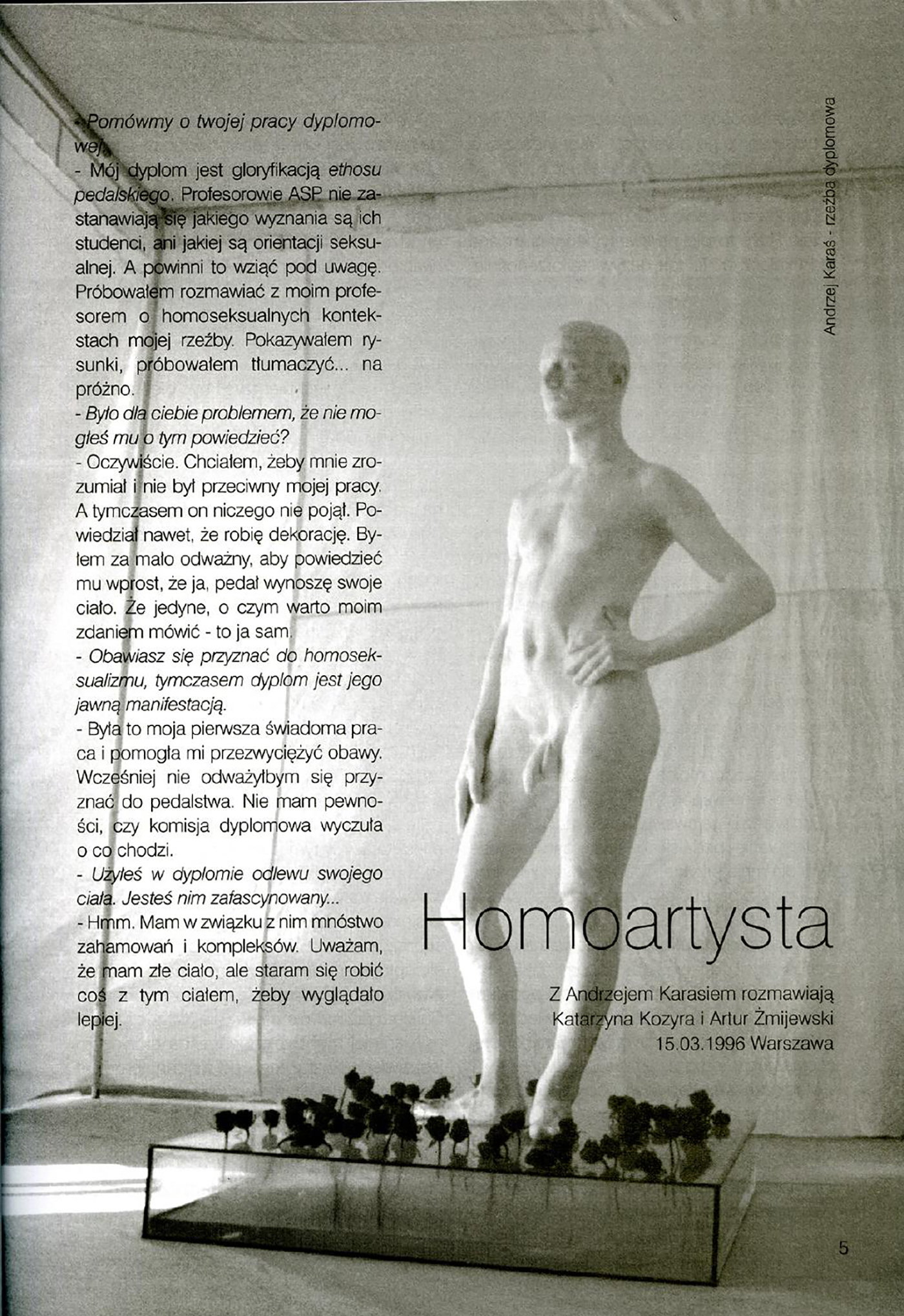
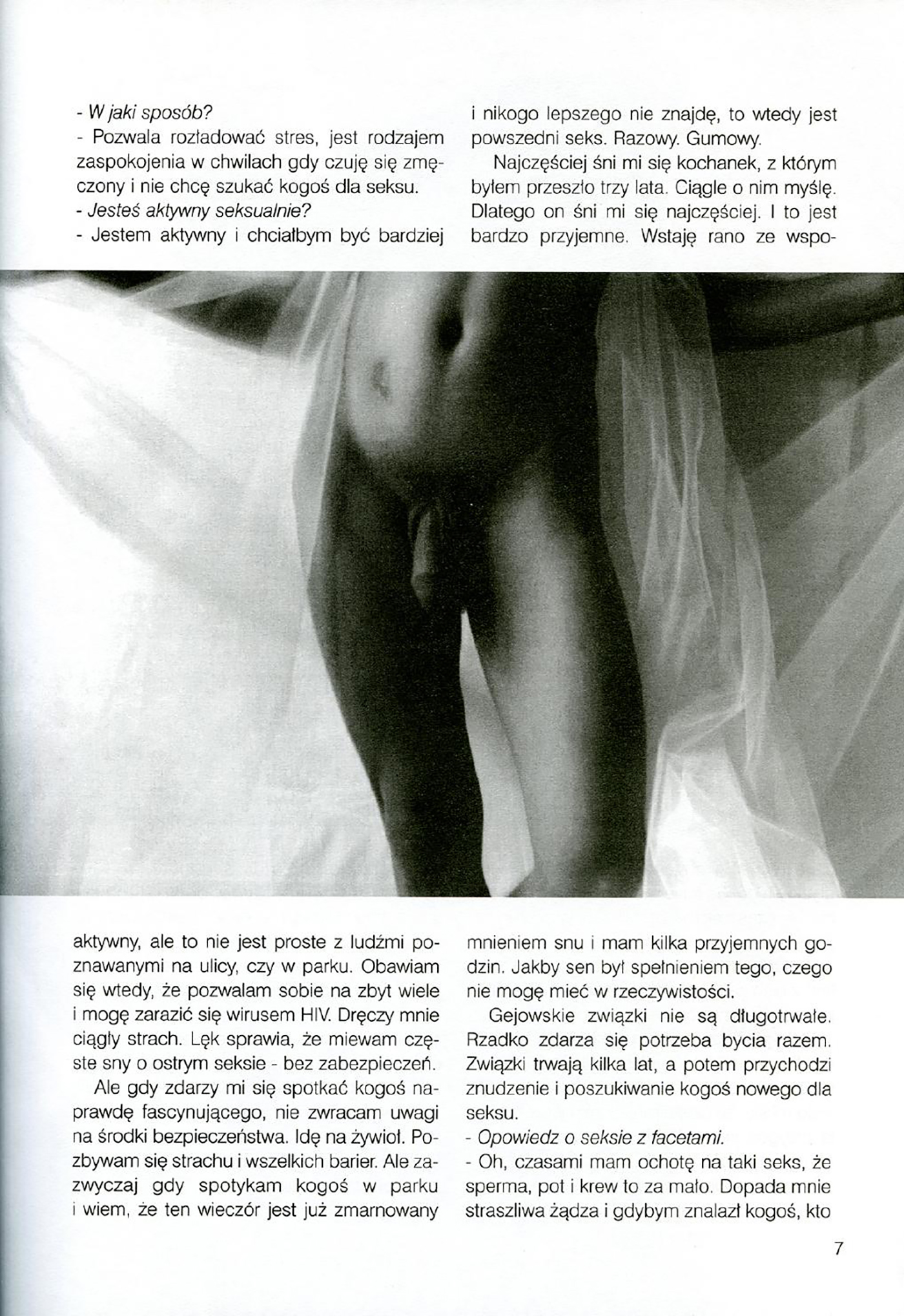
The interview is illustrated with photographs taken by Kozyra of Karaś’s nudes. These originate from the series Black and White Polaroids [Polaroidy czarno-białe] and Karaski in Bedclothes [Karaski w pościeli]. One of the photographs depicts the lower part of the chest, genitals, and thighs, and the portrayed fragment of the body is shrouded in delicate, semi-transparent drapery (fig. 11). The posture assumed by Karaś and his gesture bring to mind acts of opening up and of presenting oneself, yet the status of both is not obvious. The milky translucent fabric covers a tiny portion of the body; it merely blurs it and does not function as a veil. Still, it is there and offers the possibility of partial cover, but the gesture of opening is incomplete – although the naked body presents itself it is still vulnerable. It may become an object of desire, but it may as well be rejected. Furthermore, the central part of the composition – carefully balanced through the harmony of horizontal (arms and fabric folds) and vertical lines (part of the torso, the legs, the shape of the drapery) – features male genitals. The photographs might therefore be understood as a symbolic act of leaving the closet, coming out, and revealing and presenting oneself, a process that is never ultimately achieved and needs to be repeated by constantly exposing oneself to society.
Interestingly, the same issue also contains two texts devoted to cross-dressing. One is a short article by Jędrzej Niestrój devoted to the work of Marian Henel (fig. 12).58 Niestrój visited the abandoned studio at the mental asylum in Branice where Henel resided until his death. He describes Henel’s knotted tapestries, depicting naked women accompanied by animals, and the self-portraits for which the artist often dressed as a woman – a nurse – as well as photographs of dolls for which he sewed clothing. What emanates from the text is the artist’s solitude, social exclusion, and double nonconformity to imposed norms: living with mental illness and expressing himself through the socially unacceptable practice of cross-dressing. Niestrój’s own diploma piece acquires an interesting undertone in this context. The artist created a video of his friend Jarosław Knabel, screened on a TV set immersed in an aquarium. According to Grzegorz Kowalski, Knabel appeared as the artist’s alter ego, while the work itself concerned the gradual formation of human identity: from the self-discovery of one’s physicality, to gaining awareness, the possibility of communication, and the discovery of the metaphysical sphere.59 In reference to Niestrój’s research interests revolving around Henel and cross-dressing, it seems that what matters in this case are both the category of double subjectivity and a certain kind of isolation. We watch, or perhaps peep at, an image separated by glass and the water filling the sealed aquarium. Published several pages further along is an interview with Krzysztof Czerwiński – an entrepreneur and cross-dresser, also known as Tootsie (fig. 13).60 Although the conversation touches upon Czerwiński’s activism, including work for individuals living with HIV/AIDS, it mainly concerns everyday life. The undertones here are completely different, as the interview expresses fulfilment and satisfaction with achieved material and social status.
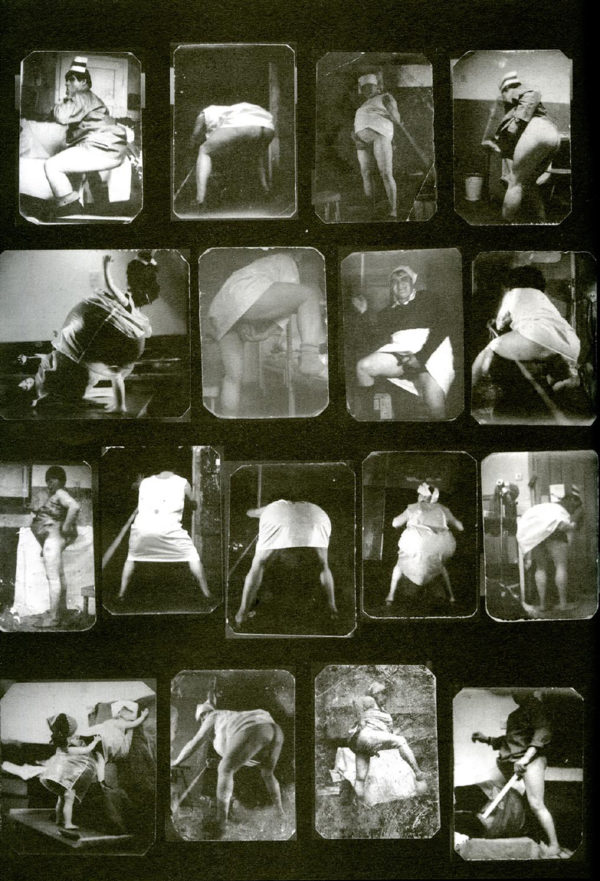
Marian Henel, „Czereja” 1998, nr 6, archiwum Muzeum Sztuki Nowoczesnej w Warszawie, archiwum Kowalni, sygn. 2783
As for the objective behind the publication of these two texts in Czereja, particularly in the context of the zine’s confrontational and critical profile, one possible reason might have been to depict different potential lifestyles, as blurred and volatile identity illustrates the erosion of conventional gender roles and challenges the status quo. However, such content did not appear within theoretical considerations of the status of homosexuality and non-heteronormativity as such. As the above examples show, these questions were treated in a somewhat instrumental way – as issues that form part of social critique. To quote Karol Sienkiewicz, “Given the lack of any models of how gays functioned in the society, Czereja depicted the existing situation. And Żmijewski asked the questions that someone unfamiliar with the topic might probably want to ask.”61 However, what is noteworthy is the presence in the field of art of the 1990s of an activity that concerned the problem of non-heteronormativity, despite the lack of broader reflection and the deficiency of methodological tools. Czereja was not a sole pioneering artistic phenomenon; it existed among other, dispersed practices, which often originated from various contexts related to non-heteronormativity, such as Krzysztof Jung’s nudes and performances in the 1970s and 1980s; the activity of the counter-cultural Repassage Gallery in Warsaw; the work of Łukasz Korolkiewicz and Zbysław Marek Maciejewski; Wojciech Misiuro’s Theater of Expression [Teatr Ekspresji] in the 1990s; as well as pieces by Krzysztof Malec (affiliated with the Academy of Fine Arts in Warsaw, participant in the abovementioned exhibition Me and AIDS) and Izabella Gustowska.62 Yet, given the issues raised in the zine, Czereja appears as a phenomenon that should become part of debates concerning non-heteronormative artistic practices.
Summary
It seems that the discussed zines attributed different objectives and meaning to non-heteronormative art, while the presented works varied significantly. The issues of challenging the taboo of the male body (and its desire) and the affirmation of homosexuality appear crucial in Filo, especially in the visual layer, although they should not be considered part of a consistent programmatic approach. In turn, non-heteronormative artistic practices and the concept of queerness in Czereja functioned as one of many fields that could be used to challenge social norms; furthermore, they appeared only in the last issues of the zine. We may even go so far as to say that the topic of homosexuality was somewhat instrumentalized – it was supposed to “shock the bourgeoisie” in a similar way to Pyramid of Animals or Roman Stańczak’s sculptural work. It was within the tradition of radical bohemia, and not activism and theoretical reflection on the social exclusion of non-heteronormative individuals. Still, even in Czereja, we may discern a certain potential for emancipation and even community-building, given the sheer fact that it allowed for non-heteronormativity to appear in the field of art, even in the Academy of Fine Arts.
As I mentioned at the beginning, this kind of analysis may also answer more general questions and issues. For, as Kate Eichhorn emphasizes, control over the present may be gained by turning to the past, through defamiliarization, which means making the accepted order of things appear strange.63 Tracing neglected, erased, and dispersed practices, but also divergences and accidentalities, opens up new possibilities of being in the world. Such practices often relate to partial or failed transformations of the social field in the past. Yet, according to Eichorn, such failed transformations might become a space in which other political possibilities come to the fore.64 Seen from such a perspective, turning to the past may be particularly vital in imagining a possible queer politics today.
Bibliography
Atton, Chris. Alternative Media. London: Sage, 2002.
Brown, Wendy. Politics Out Of History. Princeton: Princeton University Press, 2001.
de Certeau, Michel. The Practice of Everyday Life. Translated by Steven Rendall. Berkeley: University of California Press, 1984.
Dąbrowski, Jakub. Censorship in Polish Art after 1989: Art, Law, Politics. Translated by Łukasz Mojsak, Aleksandra Sobczak. Oakville: Mosaic Press, 2019.
Downing, John. Radical Media: The Political Experience of Alternative Communication. Boston: South End Press, 1984.
Duncombe, Stephen. Notes from Underground: Zines and the Politics of Alternative Culture. London: Verso, 1997.
Eichhorn, Kate. The Archival Turn in Feminism: Outrage in Order. Philadelphia: Temple University Press, 2014.
Goździewski, Marek. “Przemieszczenie tego, co odrażające.” Czereja, no. 5 (1995).
Grech, Michał, Annette Siemes, Mariusz Wszołek, ed. Badanie i Projektowanie Komunikacji, vol. 6. Wrocław-Kraków: Wydział Filologiczny Uniwersytetu Wrocławskiego, Wydawnictwo LIBRON, 2018.
Hinz, Janusz. “Interview,” conversation with Ralf König. Filo. Pismo Lesbijek i Gejów, no. 2 (1990).
Kajtoch, Wojciech. Świat prasy alternatywnej w zwierciadle jej słownictwa. Kraków: Wydawnictwo Uniwersytetu Jagiellońskiego, 1999.
Kosiewski, Piotr. “Zaproszenie w odmęty, czyli kiedyś będę papieżem.” Res Publica Nowa, no. 3 (1996).
Kozyra, Katarzyna, Artur Żmijewski. “Homoartysta,” conversation with Andrzej Karaś. Czereja, no. 6 (1998).
Kula, Marcin, ed. Kłopoty z seksem w PRL. Rodzenie nie całkiem po ludzku, aborcja, choroby, odmienności. Warsaw: Wydawnictwa Uniwersytetu Warszawskiego, 2012.
Leszkowicz, Paweł. Ars Homo Erotica, exhibition catalog. Warsaw: Muzeum Narodowe w Warszawie, 2010.
Leszkowicz, Paweł. Art Pride. Gay Art from Poland / Polska sztuka gejowska. Warsaw: Abiekt.pl, 2010.
Leszkowicz, Paweł. “Barbara Falender – Politics/Erotics.” Bedeutung, no. 1 (2007).
Leszkowicz, Paweł. Nagi mężczyzna. Akt męski w sztuce polskiej po 1945 roku. Poznań: Wydawnictwo Naukowe UAM, 2012.
Leszkowicz, Paweł, Tomasz Kitliński. Miłość i demokracja. Rozważania o kwestii homoseksualnej w Polsce. Kraków: Wydawnictwo Aureus, 2005.
Majewska, Ewa. “Public against our will? The caring gaze of Leviathan, ‘pink files’ from the 1980s Poland and the issue of privacy.” InterAlia, no. 13 (2018).
Mizielińska, Joanna. “Idee pogubione w czasie – polityka LGBT vs teoria queer w Polsce i na Zachodzie.” Przegląd Kulturoznawczy, vol. 3 (2013).
O’Sullivan, Tim, John Hartley, Danny Saunders, Martin Montgomery, John Fiske, ed. Key Concepts in Communication and Cultural Studies. London: Routledge, 1994.
Parus-Jaskułowska, Magdalena Anna Stabrowska, ed. Kultura i społeczeństwo PRL. Materiały ze Studenckiej Sesji Naukowej, Wrocław, 26 kwietnia 2001. Wrocław: Katedra Kulturoznawstwa Uniwersytetu Wrocławskiego, 2003.
Piepmeier, Alison. Girl Zines: Making Media, Doing Feminism. New York: New York University Press, 2009.
Sienkiewicz, Karol. “Konflikt i porozumienie. ‘Czereja’ w pracowni Grzegorza Kowalskiego.” Ikonotheka, no. 20 (2007).
Sienkiewicz, Karol. Zatańczą ci, co drżeli. Polska sztuka krytyczna. Kraków–Warsaw: Wydawnictwo Karakter, Muzeum Sztuki Nowoczesnej w Warszawie, 2014.
Starosta, Sławomir. “Ruch homoseksualny w Polsce. Dlaczego? Dla kogo? W jaki sposób?” Filo, no. 1 (1990).
Szcześniak, Magda. Normy widzialności. Tożsamość w czasach transformacji. Warsaw: Bęc Zmiana, 2016.
Szulc, Łukasz. Transnational Homosexuals in Communist Poland: Cross-Border Flows in Gay and Lesbian Magazines. London: Palgrave Macmillan, 2018.
Szymczyk, Adam, ed. Galeria a.r.t. 1992–1997. Płock: Galeria a.r.t. [no date].
Tomasik, Krzysztof. Gejerel. Mniejszości seksualne w PRL-u. Warsaw: Wydawnictwo Krytyki Politycznej, 2012.
Tomaszewska, Maria. “Kłopoty z ciałem.” Kresy. Kwartalnik Literacki, no. 1 (1995).
Triggs, Teal. Fanzines. London: Thames & Hudson, 2010.
Wszołek, Mariusz, Michał Grech, Annette Siemes, ed. Badanie Komunikacji, vol. 1. Wrocław-Kraków: Wydział Filologiczny Uniwersytetu Wrocławskiego, Wydawnictwo LIBRON, 2018.
Żmijewski, Artur. “Wagarując.” Gazeta Wyborcza, no. 267 (November 15, 2008).
Żmijewski, Artur, Katarzyna Kozyra. “Z wiaderkami świńskim truchtem.” Czereja, no. 5 (1995).
- See, among other titles: Alison Piepmeier, Girl Zines: Making Media, Doing Feminism (New York: New York University Press, 2009); Teal Triggs, Fanzines (London: Thames & Hudson, 2010); Chris Atton, Alternative Media (London: Sage, 2002); Key Concepts in Communication and Cultural Studies, eds. Tim O’Sullivan, John Hartley, Danny Saunders, Martin Montgomery, and John Fiske (London: Routledge, 1994); Stephen Duncombe, Notes from Underground: Zines and the Politics of Alternative Culture (London: Verso, 1997); John Downing, Radical Media: The Political Experience of Alternative Communication (Boston: South End Press, 1984). For publications in Polish, see: Mateusz Flont, “(Anty)estetyka wizualna polskich zinów. Część I – ‘trzeci obieg’ w latach 80.,” in: Badanie i Projektowanie Komunikacji vol. 6, eds. Michał Grech, Annette Siemes, and Mariusz Wszołek, (Wrocław-Kraków: Wydział Filologiczny Uniwersytetu Wrocławskiego, Wydawnictwo LIBRON, 2017), 245–264; idem, “(Anty)estetyka wizualna polskich zinów. Część II – ‘obieg alternatywny’ w latach 90.,” in: Badanie Komunikacji vol.1, eds. Mariusz Wszołek, Michał Grech, and Annette Siemes (Wrocław-Kraków: Wydział Filologiczny Uniwersytetu Wrocławskiego, Wydawnictwo LIBRON, 2018), 155–175; Wojciech Kajtoch, Świat prasy alternatywnej w zwierciadle jej słownictwa (Kraków: Wydawnictwo Uniwersytetu Jagiellońskiego, 1999). ↩︎
- Let us make a brief typological differentiation: a zine is a publicistic-informational periodical focused on a narrow group of readers, which initially formed part of musical culture. Art-zines are devoted to the visual arts, poetry, and literature, and their position is well established in Polish culture as they have functioned in the field since the beginning of the 1980s. ↩︎
- Magda Szcześniak, Normy widzialności. Tożsamość w czasach transformacji (Warsaw: Bęc Zmiana, 2016). ↩︎
- Łukasz Szulc, Transnational Homosexuals in Communist Poland: Cross-Border Flows in Gay and Lesbian Magazines (London: Palgrave Macmillan, 2018). ↩︎
- Agata Fiedotow, “Początki ruchu gejowskiego w Polsce (1981–1990),” in: Kłopoty z seksem w PRL. Rodzenie nie całkiem po ludzku, aborcja, choroby, odmienności, ed. Marcin Kula (Warsaw: Wydawnictwa Uniwersytetu Warszawskiego, 2012), 241–358. ↩︎
- Paweł Leszkowicz, Art Pride. Gay Art from Poland / Polska sztuka gejowska (Warsaw: Abiekt.pl, 2010); idem, Nagi mężczyzna: akt męski w sztuce polskiej po 1945 roku (Poznań: Wydawnictwo Naukowe UAM, 2012); idem, Ars homo erotica, exh. cat. (Warsaw: Muzeum Narodowe w Warszawie, 2010). ↩︎
- Idem, “Barbara Falender – Politics/Erotics,” Bedeutung no. 1 (2007), http://www.bedeutung.co.uk/magazine/issues/1-nature-culture/falender-politics-erotics/ (accessed September 20, 2019). ↩︎
- Karol Sienkiewicz, Zatańczą ci, co drżeli. Polska sztuka krytyczna (Kraków–Warsaw: Wydawnictwo Karakter, Muzeum Sztuki Nowoczesnej w Warszawie, 2014). ↩︎
- Szulc, Transnational Homosexuals in Communist Poland, 144. ↩︎
- See, among other publications: Ewa Majewska, “Public against our will? The caring gaze of Leviathan, ‘pink files’ from the 1980s Poland and the issue of privacy,” InterAlia no. 13 (2018), 54–77; Paweł Kurpios, “Poszukiwani, poszukiwane: Geje i lesbijki a rzeczywistość PRL,” in: Kultura i społeczeństwo PRL. Materiały ze Studenckiej Sesji Naukowej, Wrocław, 26 kwietnia 2001, eds. Magdalena Parus-Jaskułowska and Anna Stabrowska (Wrocław: Katedra Kulturoznawstwa Uniwersytetu Wrocławskiego, 2003), 27–34; Szulc, Transnational Homosexuals in Communist Poland, 106–110; Fiedotow, “Początki ruchu gejowskiego w Polsce,” 270–275; Krzysztof Tomasik, Gejerel. Mniejszości seksualne w PRL-u (Warsaw: Wydawnictwo Krytyki Politycznej, 2012), 17–46. ↩︎
- Szulc, Transnational Homosexuals in Communist Poland, 144. ↩︎
- Filo Express. Gejowski Biuletyn Kulturalny no. 7 (1987), 1. ↩︎
- The group gathered around Filo and Ryszard Kisiel in Gdańsk began to form in 1986. In 1987, Waldemar Zboralski, Sławomir Starosta, and Krzysztof Garwatowski initiated the Warsaw Homosexual Movement [Warszawski Ruch Homoseksualny], and the Amiko group was set up in Łódź. Previously established groups included Wrocław’s Etap, founded in 1983 by activists collaborating with Andrzej Selerowicz, whose activity involved distribution of the Biuletyn of the EEIP (Eastern Europe Information Pool). Established at the Austrian organization Homosexuelle Initiative Wien, the EEIP supported the development of lesbian-gay movements in Eastern Europe, with the goal of building an informal network of contacts between homosexuals – potential activists – in the region. The mission ultimately remained unaccomplished. See: Fiedotow, “Początki ruchu gejowskiego w Polsce,” 309–327. ↩︎
- Szulc, Transnational Homosexuals in Communist Poland, 144–146. ↩︎
- Ibid., 144. ↩︎
- Publication and Performances Act of July 31, 1981, JoL of 1981, No. 20, Item 99, Art. 4.1. ↩︎
- Ibid. ↩︎
- According to Magda Szcześniak, Filo initially relied on materials originating primarily from the normative scene, whereas later issues concentrated mainly on culture developed by gay milieus; see: Szcześniak, Normy widzialności. ↩︎
- These included the aforementioned Biuletyn, published by Selerowicz since 1983 (under the title Etap since 1986), distributed by post with the support of the Wrocław group; the two issues of Efebos magazine, established by the Warsaw Homosexual Movement in 1986–1987; and Kabaret from Łódź from the end of 1989. ↩︎
- Filo. Miesięcznik Kochających Inaczej no. 21 (1990), 2. ↩︎
- Ibid. ↩︎
- Ibid. ↩︎
-
Karol Sienkiewicz’s MA Dissertation Tekst równoważny dziełu. “Czereja” – pismo Artura Żmijewskiego i Kowalni [Text Equal to Artwork: “Czereja” – Magazine by Artur Żmijewski and Kowalnia], written under the supervision of Dr. Hab. Prof. Waldemar Baraniewski at the University of Warsaw, defended in 2006, is probably the most exhaustive study devoted to the topic. ↩︎
- Artur Żmijewski, “Wagarując,” Gazeta Wyborcza no. 267, November 15, 2008, 32. ↩︎
- Karol Sienkiewicz, “Konflikt i porozumienie. ‘Czereja’ w pracowni Grzegorza Kowalskiego,” Ikonotheka no. 20 (2007), 187. ↩︎
- Ibid., 187–188. ↩︎
- Ibid. ↩︎
- “Informacja: Dla kogo Czereja,” Archive of the Museum of Modern Art in Warsaw, Kowalnia Archive, sign. 3623. ↩︎
- Sienkiewicz, “Konflikt i porozumienie,” 186. ↩︎
- Maria Tomaszewska, “Kłopoty z ciałem,” Kresy. Kwartalnik Literacki no. 1 (1995), 302–305; Piotr Kosiewski, “Zaproszenie w odmęty, czyli kiedyś będę papieżem,” Res Publica Nowa no. 3 (1996), 22–25; from: Sienkiewicz, “Konflikt i porozumienie,” 187. ↩︎
- “Z wiaderkami świńskim truchtem,” Katarzyna Kozyra in conversation with Artur Żmijewski, July 10, 1993, Czereja no. 5 (1995), Archive of the Museum of Modern Art in Warsaw, Kowalnia Archive, sign. 2528, 28–34. The interview was also published in Magazyn Sztuki no. 5 (1995), 17–28. ↩︎
- Marek Goździewski, “Przemieszczenie tego, co odrażające,” Czereja no. 5 (1995), 37. ↩︎
- The debate is reconstructed in: Jakub Dąbrowski, Censorship in Polish Art after 1989: Art, Law, Politics, trans. Łukasz Mojsak and Aleksandra Sobczak (Oakville: Mosaic Press, 2019). ↩︎
- Aside from the still-published Filo, other socio-cultural magazines published in the 1990s are worth mentioning here, such as Inaczej (1990–2002) from Poznań, which also included articles about art and culture, as well as Okay (1990–1993) and Gayzeta Nie? Tak! (1990–1991), both from Warsaw. ↩︎
- Filo Express. Gejowski Biuletyn Kulturalny no. 2 (1986), 4. ↩︎
- Ibid. ↩︎
- Michel de Certeau, The Practice of Everyday Life, trans. Steven Rendall (Berkeley: University of California Press, 1984), 47–58. ↩︎
- Filo Express. Gejowski Biuletyn Kulturalny no. 2 (1986), 4. ↩︎
- Leszkowicz, Nagi mężczyzna, 156–160. ↩︎
- “Interview,” Ralf König in conversation with Janusz Hinz, Filo. Pismo Lesbijek i Gejów no. 2 (20) (1990), 13–15. ↩︎
- Discussing the division of non-heteronormative milieus in Poland in the 1990s, Magda Szcześniak concentrates on two identity projects. The first pursued the goal of assimilating those circles into heteronormative society and undertook activities toward gaining acceptance at the price of adjusting to the majority. The second opposed the acceptance of the norms of the dominant groups; Szcześniak, Normy widzialności. ↩︎
- Touko Valio Laaksonen (1920–1991), pseudonym: Tom of Finland, draftsman, illustrator, painter. Tom of Finland developed highly masculine, fetishistic, homoerotic imagery, exerting a major influence on gay culture. ↩︎
- A. [Artur] Jeffmański, Janusz H. [Hinz], “Tom of Finland,” Filo. Pismo Lesbijek i Gejów no. 3 (1989), 15. ↩︎
- Ibid. ↩︎
- Ibid. ↩︎
- Sławomir Starosta, “Ruch homoseksualny w Polsce. Dlaczego? Dla kogo? W jaki sposób?,” Filo no. 1 (19) (1990), 11–12. ↩︎
- See: Szcześniak, Normy widzialności. ↩︎
- See: Joanna Mizielińska, “Idee pogubione w czasie – polityka LGBT vs teoria queer w Polsce i na Zachodzie,” Przegląd Kulturoznawczy vol. 3 (2013), 287–301. ↩︎
- Paweł Leszkowicz and Tomasz Kitliński, Miłość i demokracja. Rozważania o kwestii homoseksualnej w Polsce (Kraków: Wydawnictwo Aureus, 2005), 179–180. ↩︎
- Sienkiewicz, Zatańczą ci, co drżeli. ↩︎
- Andrea Juno and V. Vale, Angry Women (San Francisco: RE/Search, 1991). ↩︎
- “Kathartyczny śluz z ust,” Annie Sprinkle in conversation with Andrea Juno, trans. Katarzyna Kozyra, collaboration: Artur Żmijewski, Czereja no. 5 (1995), 8–12. ↩︎
- “Sucza idiosynkrazja,” Diamanda Galás in conversation with Andrea Juno, trans. Ewa Kozyra, collaboration: Hersh Krukoski, Czereja no. 5 (1995), 12–16. ↩︎
- From: Sienkiewicz, “Konflikt i porozumienie,” 188. ↩︎
- Ja i AIDS, the Stolica cinema, Warsaw, January 9 – February 9, 1996, curator: Grzegorz Kowalski, co-curators: Katarzyna Kozyra and Artur Żmijewski; artists: Paweł Althamer, Edyta Daczka, Katarzyna Górna, Andrzej Karaś, Grzegorz Kowalski, Katarzyna Kozyra, Ryszard Lech, Krzysztof Malec, Małgorzata Minchberg, Jacek Markiewicz, Jędrzej Niestrój, Monika Osiecka-Leczew, Artur Żmijewski. ↩︎
- “Homoartysta,” Andrzej Karaś in conversation with Katarzyna Kozyra and Artur Żmijewski, Czereja no. 6 (1998), Archive of the Museum of Modern Art in Warsaw, Kowalnia Archive, sign. 2783, 5–13. ↩︎
- Ibid., 5. Subsequent quotes originate from the same interview. ↩︎
- Jędrzej Niestrój, “Branickie Arrasy. O Marianie Henelu i jego dziełach,” Czereja no. 6 (1998), 14–19. ↩︎
- Galeria a.r.t. 1992–1997, ed. Adam Szymczyk (Płock: Galeria a.r.t., [no date]), 129–130. ↩︎
- “Królowa delikatesów,” Ciocia Kris [Krzysztof Czerwiński] in conversation with Katarzyna Kozyra and Artur Żmijewski, Czereja no. 6 (1998), 54–61. ↩︎
- Sienkiewicz, Zatańczą ci, co drżeli. ↩︎
- Leszkowicz and Kitliński, Miłość i demokracja, 193. ↩︎
- Wendy Brown, Politics Out Of History (Princeton: Princeton University Press, 2001), from: Kate Eichhorn, The Archival Turn in Feminism: Outrage in Order (Philadelphia: Temple University Press, 2014), 8. ↩︎
- Eichhorn, The Archival Turn in Feminism, 9. ↩︎
Luiza Kempińska
Art historian, PhD candidate at the Department of the History of Contemporary Art at the Institute of Art History, Adam Mickiewicz University in Poznań. Kempińska is currently preparing her doctoral dissertation, devoted to artistic and exhibition-related emancipatory practices in Poland during the political regime transformation. Researcher in the grant-funded project History of Women’s Art Exhibitions in Poland (NCN, 2014–2017); research group member of the project Creative Sick States / Kreatywne stany chorobowe carried out at the Arsenał Municipal Gallery in Poznań (2018–2019). Kempińska is currently participating as a teaching assistant in the project Gender Politics and the Art of European Socialist States (The Getty Foundation, 2019–2020).



